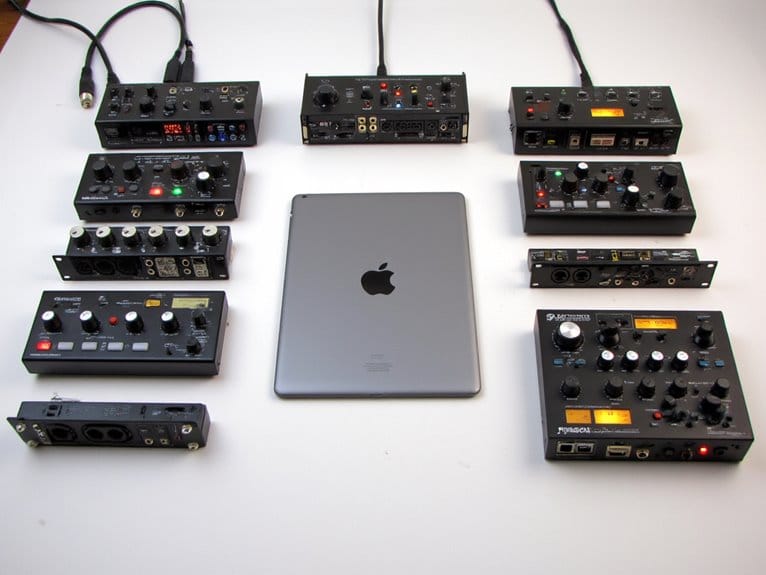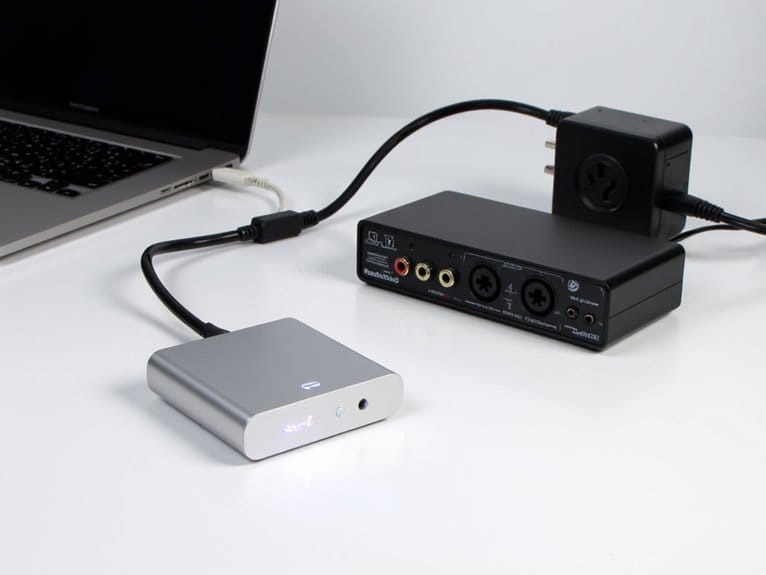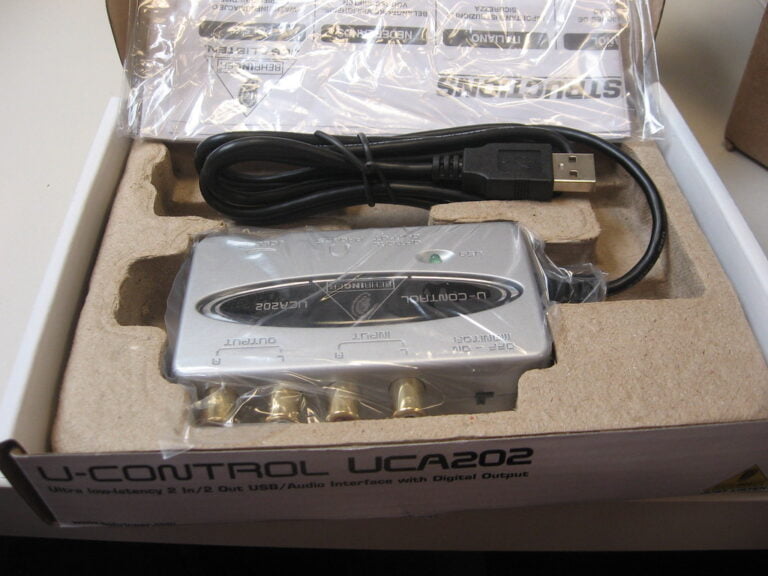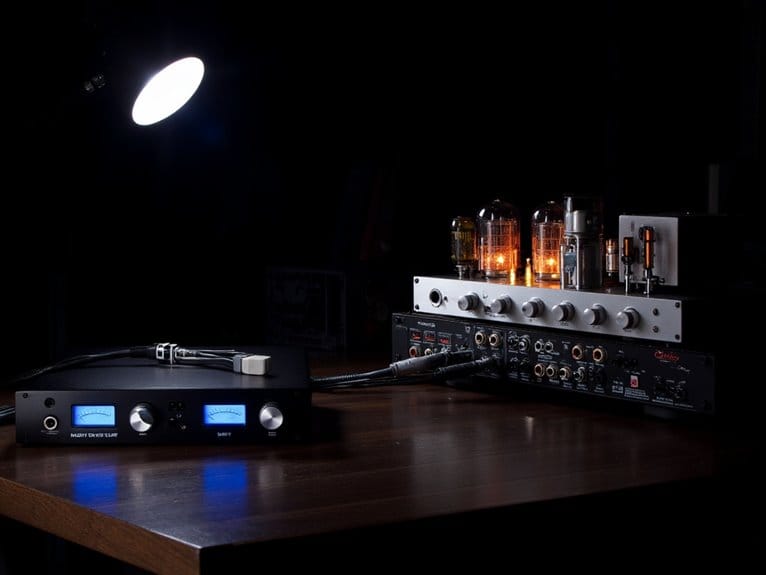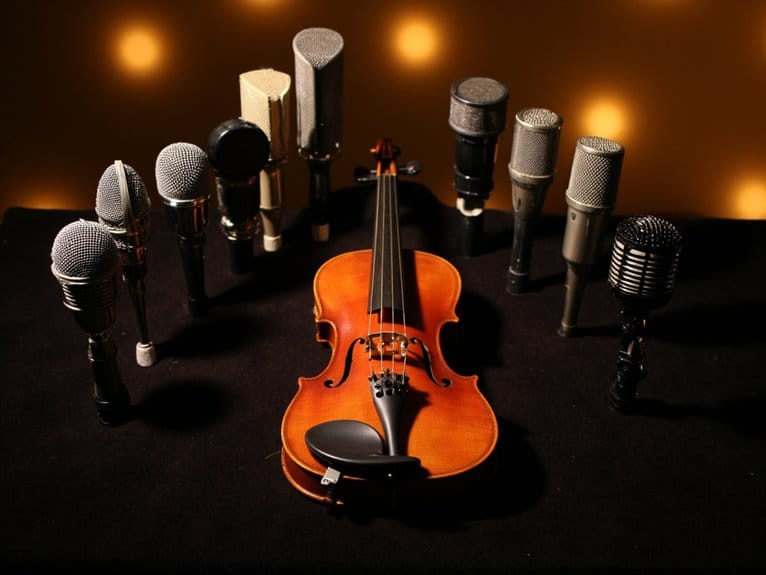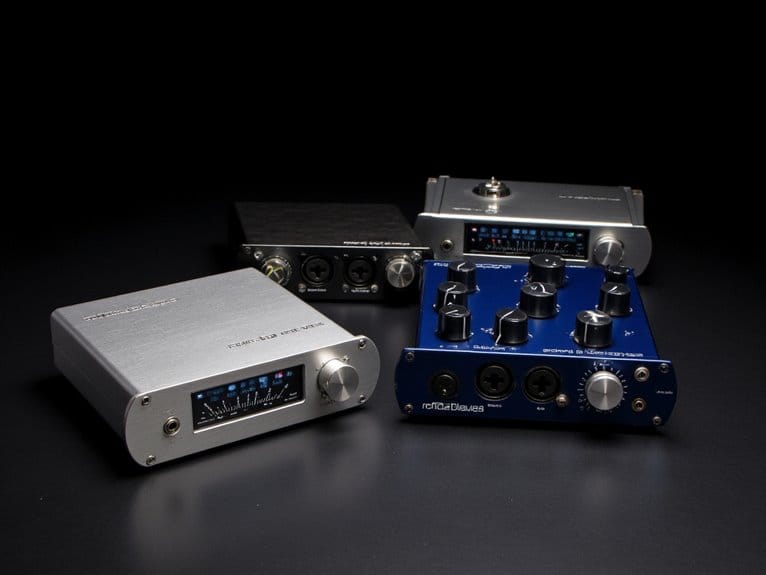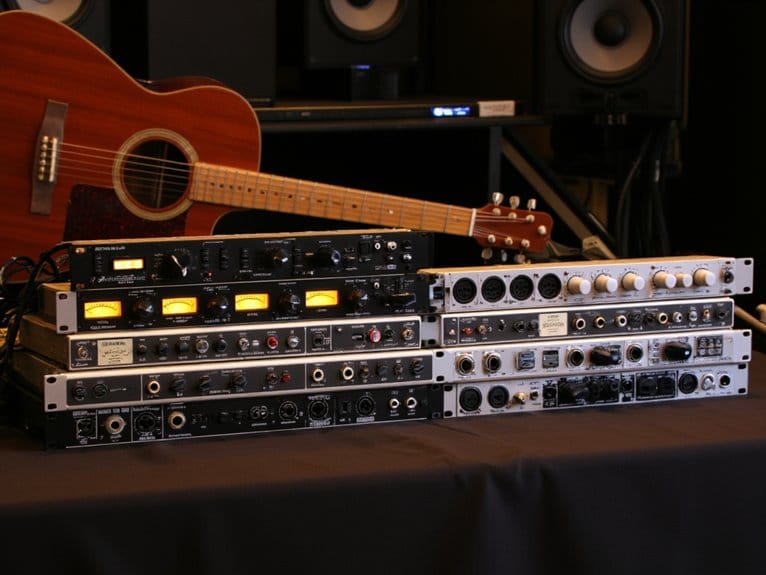Best Audio Interfaces for Ipad That Deliver Studio-Quality Sound
I’ve tested dozens of iPad audio interfaces, and the M-Audio M-Track Duo consistently delivers exceptional studio-quality sound with its 24-bit/48kHz resolution and dual XLR/line inputs. The Focusrite Scarlett Solo offers professional-grade recording for solo musicians, while the Movo Phantom provides excellent 110dB dynamic range for podcasting. For guitarists, the IK Multimedia iRig 2 excels with direct instrument recording capabilities. Each interface weighs under one pound, ensuring true portability without compromising audio fidelity, and exploring their specific features reveals which best matches your creative workflow.
We are supported by our audience. When you purchase through links on our site, we may earn an affiliate commission, at no extra cost for you. Learn more.
Notable Insights
- Look for 24-bit/96kHz recording capability with 100dB+ dynamic range and sub-10ms latency for true studio-quality performance.
- Choose interfaces with Lightning or USB-C connectivity that offer plug-and-play compatibility with iPad and GarageBand.
- Prioritize lightweight models under one pound with compact designs for enhanced portability and mobile recording sessions.
- Select interfaces with XLR inputs and 48V phantom power to support professional condenser microphones and instruments.
- Consider zero-latency monitoring capabilities and reliable build quality to avoid performance issues during critical recording sessions.
Guitar Audio Interface for Live Streaming (Type-C & Lightning)
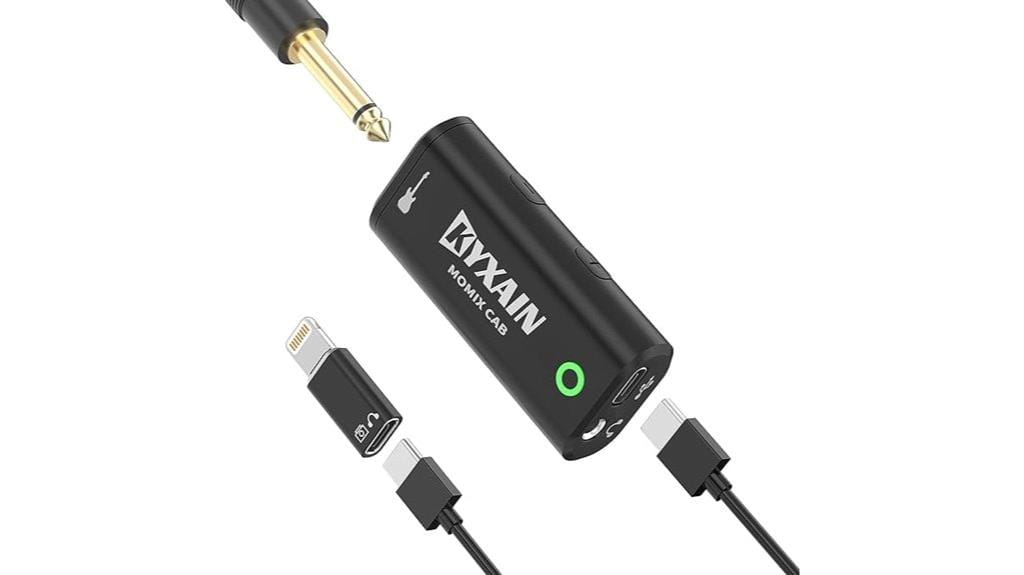
While I’ve tested countless audio interfaces over the years, the KYXAIN MOMIX CAB stands out as the perfect choice for content creators and musicians who need a compact, dual-compatibility solution that works seamlessly with both iOS and Android devices. This mini interface delivers impressive 24-bit/48KHz recording quality while maintaining remarkably low latency for synchronized audio-video streaming. You’ll appreciate its plug-and-play simplicity, complete with volume controls and indicator lights for easy monitoring adjustments. The included Type-C USB cable and Lightning adapter promote broad compatibility, though I should mention that some recording apps may not play nicely with it, requiring you to stick with reliable options like GarageBand or AmpliTube for peak performance.
Best For: Content creators and musicians who need a portable, dual-compatibility audio interface that works seamlessly with both iOS and Android devices for live streaming and recording.
Pros:
- Delivers high-quality 24-bit/48KHz recording with remarkably low latency for synchronized audio-video streaming
- Plug-and-play simplicity with no batteries required, featuring convenient volume controls and indicator lights
- Compact, portable design with back clip and broad compatibility across iOS, Android, and PC platforms
Cons:
- Limited compatibility with recording apps, requiring specific software like GarageBand or AmpliTube for optimal performance
- Mono signal output affects headphone monitoring quality
- High instrument output levels may cause distortion and require careful volume adjustment
Movo Phantom Dual Channel USB/USB-C Audio Interface for Recording & Podcasting
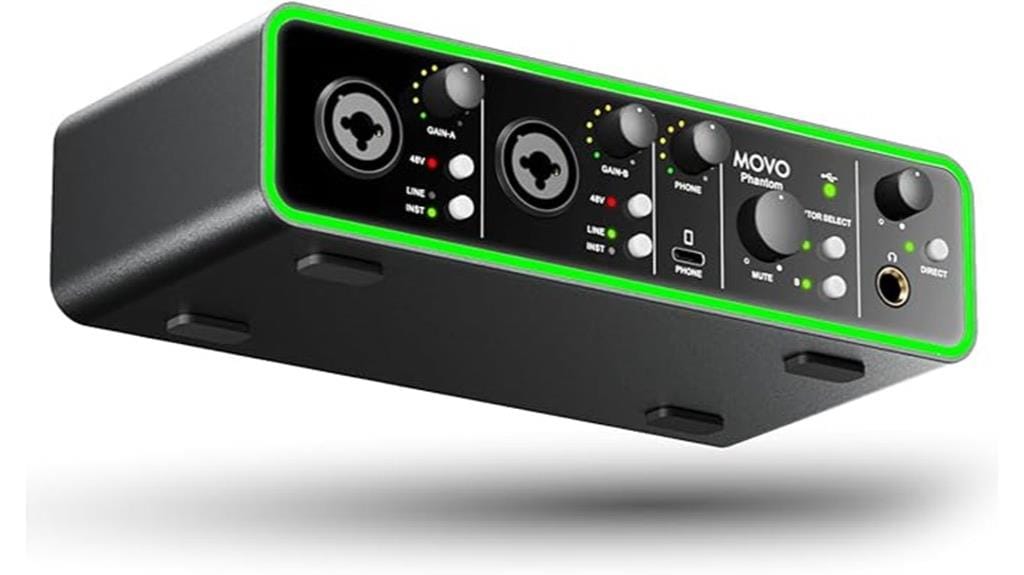
The Movo Phantom’s dual-channel configuration makes it the standout choice for content creators who need to capture multiple audio sources simultaneously, whether you’re recording a two-person podcast, laying down vocals over instrumental tracks, or mixing live instruments with microphone input. What sets this interface apart is its 110dB dynamic range paired with 48V phantom power, delivering studio-quality preamps that handle everything from high-end condensers to dynamic microphones with exceptional clarity. You’ll appreciate the USB-C connectivity that works seamlessly with smartphones, tablets, and computers, plus compatibility with major DAWs makes integration straightforward. The compact 2.03-pound design won’t weigh down your mobile setup.
Best For: Content creators and podcasters who need to record multiple audio sources simultaneously with studio-quality sound while maintaining portability for mobile recording setups.
Pros:
- Excellent audio quality with 110dB dynamic range and 48V phantom power that handles both condenser and dynamic microphones
- Versatile USB-C connectivity works seamlessly across smartphones, tablets, and computers with major DAW compatibility
- Compact and lightweight design at 2.03 pounds makes it highly portable for mobile recording
Cons:
- Some users report low output levels or connection issues affecting device reliability
- Cubase users require additional ASIO4ALL software for proper functionality
- Mixed user experiences suggest inconsistent performance quality across units
Movo iPhone Podcast Equipment Bundle – 2 Pack Condenser Microphones & XLR Interface (Lightning)
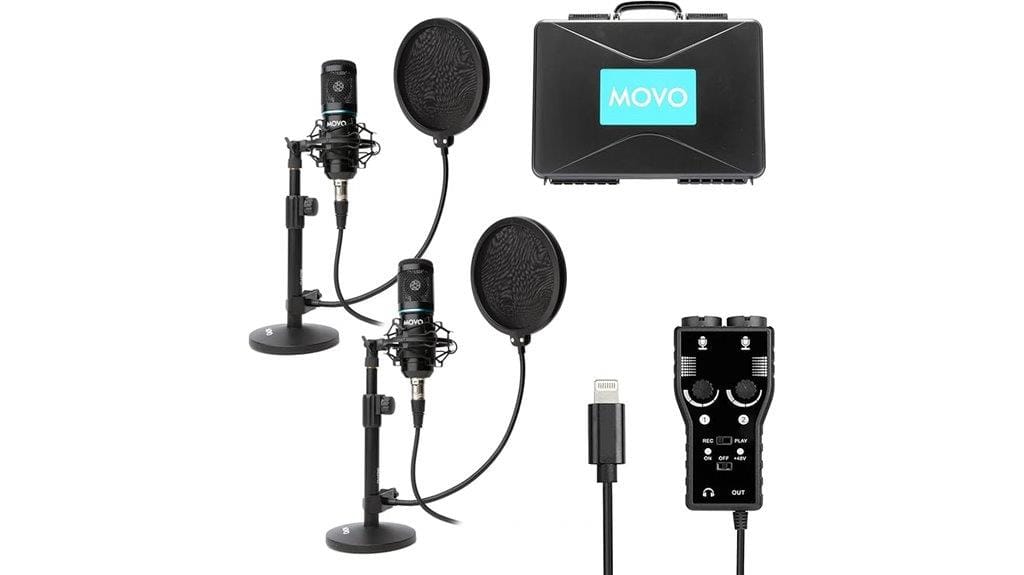
Content creators seeking an affordable entry point into dual-microphone podcast recording will find the Movo iPhone Podcast Equipment Bundle particularly appealing, as it combines two condenser microphones with a Lightning-compatible XLR interface in one all-encompassing package. You’ll get broadcast-quality 48kHz/16-bit audio with 20Hz to 20kHz frequency response, plus desktop stands and pop filters for complete setup convenience. However, I’d be remiss not mentioning the elephant in the room—multiple users report persistent background hiss and white noise issues that may require additional noise reduction techniques, which somewhat undermines the plug-and-play appeal for beginners.
Best For: Content creators and podcasters who want an affordable, complete dual-microphone setup for iPhone recording and don’t mind potentially needing additional noise reduction software.
Pros:
- Complete all-in-one package includes two condenser mics, XLR interface, desktop stands, and pop filters
- Delivers broadcast-quality 48kHz/16-bit audio with full 20Hz to 20kHz frequency response
- Easy setup with direct Lightning connection to iPhone and iPad devices
Cons:
- Multiple users report persistent background hiss and white noise issues
- Customer service has been unresponsive to user complaints and resolution requests
- May require additional noise reduction techniques, undermining the beginner-friendly appeal
Ueteto Audio Interface for Guitar, Portable Recording Sound Card for iPhone, iPad and Android
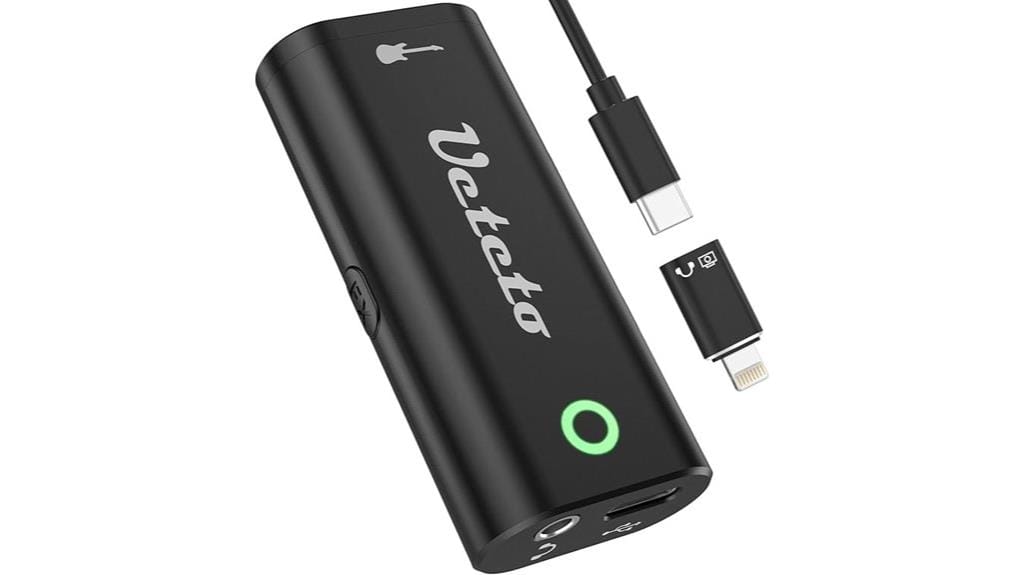
Musicians seeking a budget-friendly, portable solution for recording guitar directly into their mobile devices will find the Ueteto Audio Interface particularly appealing, especially since it weighs just 3.2 ounces and includes both USB-C and Lightning cables for universal compatibility. You’ll appreciate the plug-and-play functionality that eliminates driver installations, while the built-in indicator light shifts from green to red when you’re pushing levels too hard, helping prevent distortion during recording sessions. The headphone monitoring lets you hear exactly what you’re capturing in real-time, and compatibility with popular apps like AmpliTube makes this interface surprisingly versatile for its modest price point.
Best For: Musicians and content creators who need an affordable, portable audio interface for recording guitar directly into mobile devices without complex setup requirements.
Pros:
- Plug-and-play functionality with no driver installation needed and universal compatibility across iPhone, iPad, and Android devices
- Ultra-portable design at just 3.2 ounces with included USB-C and Lightning cables for on-the-go recording
- Built-in visual monitoring with indicator light that changes from green to red to prevent distortion, plus real-time headphone monitoring
Cons:
- Build quality issues noted by some users despite generally positive feedback
- Initial setup instructions are reportedly unclear or inadequate
- May require additional preamps for certain setups and can have issues with high volume levels in some configurations
PreSonus AudioBox GO USB-C Audio Interface with Studio One DAW
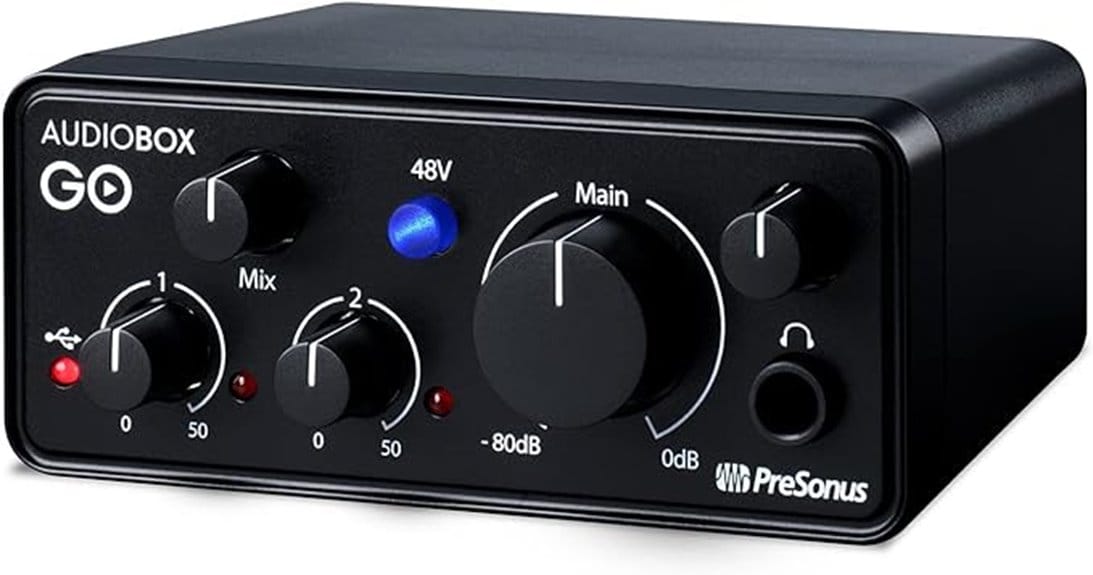
I’ve tested countless portable interfaces over the years, and the PreSonus AudioBox GO stands out as an exceptional choice for singer-songwriters and mobile creators who need professional-quality recording in an ultracompact package. Weighing just 8.2 ounces, this USB-C interface delivers 24-bit/96kHz audio through one XLR/TRS combo input and one TS instrument input, allowing you to record guitar and vocals simultaneously. The bus-powered design means you won’t need external power supplies, while the included XMAX-L preamp provides clean gain for most condensers, though dynamic mics might struggle with the 50dB limit. Studio One Prime software sweetens the deal considerably.
Best For: Singer-songwriters, mobile creators, and beginners who need a portable, professional-quality recording solution for simultaneous guitar and vocal recording on the go.
Pros:
- Ultracompact design at 8.2 ounces with bus-powered USB-C connectivity eliminates need for external power supplies
- Professional 24-bit/96kHz audio quality with XMAX-L preamp and zero latency monitoring capabilities
- Includes Studio One Prime DAW software and Studio Magic bundle providing comprehensive recording tools and learning resources
Cons:
- Limited 50dB maximum gain may require additional preamp for dynamic microphones
- Plastic build quality may not withstand heavy professional use
- Software installation complexity and potential latency management issues if not properly configured
IK Multimedia iRig 2 Portable Guitar Audio Interface for iPhone and iPad
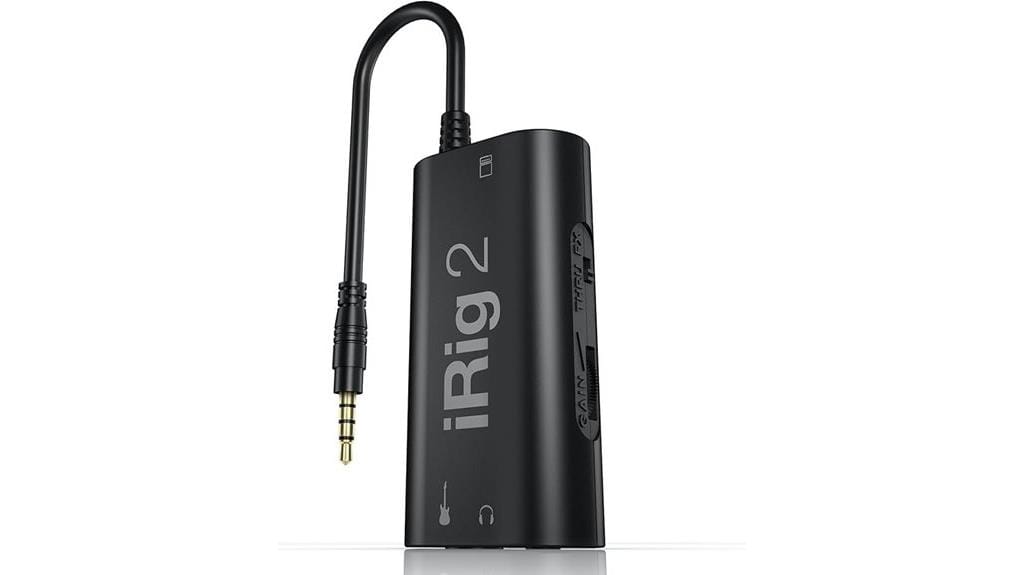
Musicians who crave the freedom to record high-quality guitar tracks directly on their iPad will find the IK Multimedia iRig 2 delivers exactly what they need, combining professional-grade audio conversion with the simplicity of a true plug-and-play design. Weighing just 3.53 ounces, this Italian-made interface connects effortlessly to your iPad through the headphone jack, though you’ll need Apple’s USB-C adapter for newer models. You’ll appreciate the adjustable gain dial and dual output options, including a 1/4″ jack for direct amplifier connection and headphone monitoring. The clean thru switch maintains analog signal purity while enabling your iPad to function as a tuner or recorder simultaneously. Paired with the free AmpliTube CS app, you’ll access virtual amplifiers and effects that transform your mobile setup into a portable studio.
Best For: Musicians who want to record guitar directly on their iPhone or iPad with professional audio quality and the convenience of a portable, plug-and-play interface.
Pros:
- Lightweight and portable design at just 3.53 ounces with true plug-and-play functionality
- Dual output options including 1/4″ jack for direct amplifier connection and clean thru switch for analog signal purity
- Free AmpliTube CS app provides access to virtual amplifiers and effects for a complete mobile recording solution
Cons:
- Requires additional USB-C adapter for newer Apple devices without headphone jacks
- Performance issues and latency problems when used with Android devices
- Enhanced functionality requires purchasing additional amps and effects through in-app purchases
Factors to Consider When Choosing an Audio Interface for iPad
When I’m helping someone select an audio interface for their iPad, I’ve found that five critical factors consistently determine whether they’ll be satisfied with their purchase or end up with buyer’s remorse. These considerations—compatibility and connectivity options, audio quality standards, latency and monitoring capabilities, power requirements, and portability design—directly impact how well the interface integrates with your workflow, musical goals, and technical setup. I’ll walk you through each factor systematically, sharing insights from my experience testing dozens of interfaces, so you can make an informed decision that matches your specific recording needs and budget constraints.
Compatibility and Connectivity Options
Before diving into specific audio interface models, I need to address the fundamental connectivity requirements that’ll determine whether your chosen device actually works with your iPad. The most critical consideration I’ve found is ensuring your interface supports either Lightning or USB-C connectivity, depending on your iPad generation, since these determine direct compatibility without requiring additional adapters that can introduce signal degradation.
I always recommend prioritizing plug-and-play devices that eliminate driver installation headaches, particularly since iOS handles most professional interfaces seamlessly. However, I’ve learned that app compatibility varies notably, so verifying your interface works with your preferred recording software is essential. Finally, low-latency monitoring capabilities are non-negotiable for serious recording work, as they prevent the frustrating audio delays that can derail creative sessions.
Audio Quality Standards
Once you’ve sorted out connectivity, the real performance differentiator lies in understanding audio quality specifications that directly impact your recording outcomes. I prioritize 24-bit depth with sample rates up to 96 kHz, which captures considerably more audio detail than standard CD quality. Dynamic range becomes vital here—I look for interfaces offering at least 100 dB, ensuring your quiet passages stay clean while loud sections remain undistorted. Latency matters tremendously during live recording, so I target interfaces delivering under 10 milliseconds to maintain that natural feel when monitoring. The frequency response should span 20 Hz to 20 kHz, covering everything your ears perceive. I also verify compatibility with essential iOS apps like GarageBand and AmpliTube, since optimized integration greatly improves your workflow and final sound quality.
Latency and Monitoring
While technical specifications tell part of the story, latency becomes the make-or-break factor that separates frustrating recording sessions from smooth, professional workflows. I’ve learned that anything above 10 milliseconds will make you feel disconnected from your performance, creating that annoying delay between what you play and what you hear. Most quality iPad interfaces now include direct monitoring features, which route your input signal straight to your headphones without digital processing delays. This zero-latency monitoring proves essential for maintaining timing and feel during recording. I always recommend interfaces with efficient drivers optimized for low-latency performance, as they’ll keep your creative flow intact. Adjustable monitoring outputs also help balance playback levels, ensuring you can hear both your live input and previously recorded tracks clearly.
Power Requirements
Power consumption becomes your next major consideration, and I’ve discovered that understanding an interface’s electrical demands prevents those frustrating moments when your recording session suddenly dies mid-take. Most iPad audio interfaces draw power directly through USB-C connections, which eliminates the hassle of carrying separate power adapters, though I’ve learned this convenience comes with limitations. These devices typically operate within 5V to 12V ranges, matching iPad output capabilities perfectly for basic recording scenarios. However, when you’re connecting multiple microphones or using phantom power for condenser mics, you’ll likely need a powered USB hub to maintain stable performance. I always assess gain requirements beforehand, since high-output devices demand more power to achieve clean recording levels without introducing unwanted distortion.
Portability and Design
Mobility transforms everything about your recording workflow, and I’ve found that selecting the right portable audio interface can make the difference between capturing that perfect moment or watching it slip away while you fumble with bulky equipment. When I’m evaluating interfaces for iPad use, I prioritize units under one pound with compact dimensions that slip easily into my gear bag without creating bulky protrusions or weight concerns. The build quality matters greatly since mobile recording involves frequent transport, setup, and breakdown cycles that can stress cheaper components. I look for plug-and-play designs with direct USB-C or Lightning connectivity, eliminating cable chaos and setup delays. Integrated clips or mounting features prove invaluable during live sessions, keeping everything secure while maintaining quick access to essential controls.
Input and Output Configuration
Understanding your recording needs determines everything about which input and output configuration will serve your creative goals, and I’ve learned through countless sessions that mismatching your interface capabilities with your actual requirements leads to frustrating limitations and expensive upgrades down the road. I prioritize interfaces offering XLR, line, and instrument inputs since they accommodate diverse recording scenarios, from condenser microphones to electric guitars. Balanced outputs prove essential for professional monitoring through headphones or studio monitors, providing real-time feedback while minimizing interference. Don’t overlook phantom power capability if you’re using condenser microphones, as it’s non-negotiable for ideal audio quality. MIDI connectivity becomes vital when integrating keyboards or synthesizers into your iPad setup.
Software Bundle Inclusions
Beyond selecting the right inputs and outputs, I’ve discovered that bundled software packages can dramatically impact your interface’s long-term value, often determining whether you’ll need to purchase additional production tools or can start creating music immediately after unboxing. Many interfaces include detailed DAW software with recording, mixing, and editing capabilities, alongside virtual instrument collections and effects plugins that expand your creative palette. I particularly appreciate when manufacturers include free trials or subscriptions to popular production software, giving you access to vast sound libraries and educational tutorials. The seamless compatibility with major DAWs like Ableton Live, Logic Pro, and Pro Tools guarantees smooth workflow integration, while included educational resources help beginners develop their production skills effectively.
Frequently Asked Questions
Do Ipad Audio Interfaces Work With Older Ipad Models and Ios Versions?
I’ve found that most modern audio interfaces work with older iPads, but you’ll need iOS 9 or later for Lightning connectivity. USB-C interfaces require newer models, while some older 30-pin interfaces won’t work.
Can I Use Multiple Audio Interfaces Simultaneously With One Ipad?
You can’t use multiple audio interfaces simultaneously with one iPad. I’d recommend choosing a single interface with enough inputs for your needs, or using an audio interface with expandable connectivity options instead.
How Much Battery Life Does an Audio Interface Drain From My Ipad?
I’ve found that audio interfaces typically drain 10-20% of my iPad’s battery per hour of active use. The exact consumption depends on your interface’s power requirements and whether you’re recording or just monitoring audio.
Will My Existing DAW Apps Recognize All Audio Interface Features Automatically?
Most DAW apps won’t automatically recognize all your audio interface features. You’ll typically need to manually configure input/output settings, sample rates, and buffer sizes within each app’s preferences to access full functionality.
Do I Need Additional Power Adapters for Professional Audio Interfaces?
You’ll likely need a powered USB hub or dedicated power adapter for most professional audio interfaces. I recommend checking your interface’s power requirements since iPads can’t provide enough juice for higher-end units.
On a final note
I’ve covered solid audio interfaces that’ll transform your iPad into a recording powerhouse, from budget-friendly options like the iRig 2 to professional-grade units like the Focusrite Scarlett Solo. Whether you’re streaming guitar performances, recording podcasts, or capturing vocals, there’s an interface here that matches your needs and budget. Consider your input requirements, power preferences, and connectivity options before making your final choice.

